The foundation: Building a consistent serve
A strong serve begins with a solid foundation, akin to constructing a sturdy house. Without a reliable base, everything else can crumble. A consistent serve is essential as it can minimize errors and maximize opportunities for winning points.
Why consistency is king
The importance of serve accuracy can hardly be overstated. When players can serve with consistency, they send a clear message to their opponents: they are in control. A player who serves well takes on a commanding presence on the court, as they can rely on their ability to place the ball accurately and with purpose. Consistency in serving not only facilitates better rallies but also builds confidence. Each successful serve serves as a psychological boost, reaffirming the player’s capabilities and strategy.
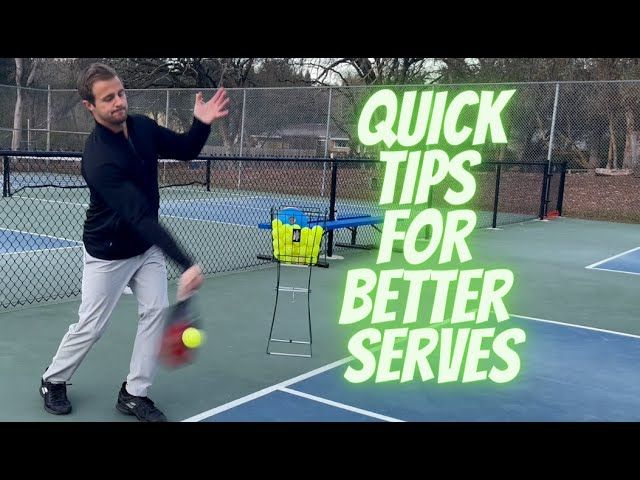
Anatomy of a perfect serve
To achieve pickleball serve technique, players should focus on the four essential elements: grip, stance, toss, and follow-through. Begin by holding the paddle with a relaxed yet firm grip to allow for maximum control. Your stance should be shoulder-width apart, with feet positioned for balance and stability.
- Grip: A loose grip can foster more fluid motions and a softer touch, while a tighter grip may contribute to a more powerful serve.
- Stance: Position your non-dominant foot slightly ahead of the other for optimal weight distribution.
- Toss: The ball toss should be consistent in height and placement generally around shoulder height to ensure an optimal contact point.
- Follow-through: A complete follow-through focusing towards your target enhances accuracy and strength.
Avoiding common serving faults
When it comes to pickleball serve rules, being aware of common mistakes can drastically improve your game. For instance, foot faults occur when a player's foot crosses the baseline before making contact with the ball. Another common pitfall is failing to serve below the waist, which can result in an instant fault. Training your mind to avoid these errors will help solidify your serving reliability. Using video or gaining feedback from peers can be invaluable for pinpointing specific issues and making adjustments accordingly.
Adding power: Engaging your body for a stronger serve
An effective serve is not just about technique; it's also about utilizing your body as a cohesive unit. To unlock your full potential in terms of power, you'll need to engage not only your arms but also your core and legs.
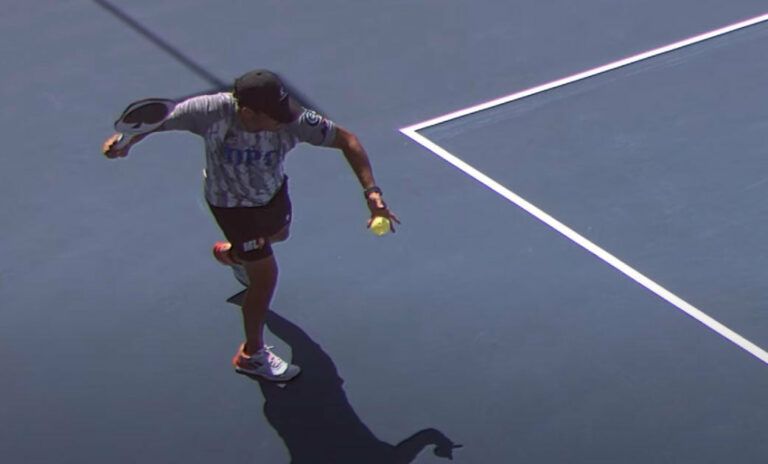
Beyond the arm: The power of core and legs
The core engagement and leg drive play pivotal roles in enhancing your pickleball serve power. Relying solely on the arm can lead to fatigue and inconsistencies; instead, leverage your core muscles to provide stability and strength. When preparing to serve, ensure that your weight starts on your back foot. As you initiate the swing, shift your weight toward your front foot, effectively generating momentum that travels throughout your body and into the paddle.
- Strong base: A shoulder-width foothold allows for a robust and powerful serve.
- Movement: The body should operate in a synchronized manner, where each body part works as part of a kinetic chain.
Weight transfer: Unlocking your full potential
Understanding pickleball serve weight shift is crucial for exploiting the kinetic chain effectively. When you serve, initiate the motion from your legs, transitioning power through your core, and finally into the arm. This interplay of muscles creates an explosive release of energy toward the ball, resulting in a more powerful shot.
Fine-tuning grip pressure for power and control
Mastering the pickleball paddle grip and the amount of pressure applied during the serve can dramatically affect both power and control. For instance, gripping too tightly may cause tension, reducing accuracy and fluidity. Conversely, a too-loose grip might lead to over-hitting or loss of control.
- Experiment with pressures: Practice different grips under various conditions to find your optimal balance.
- Engage your fingers: Using your fingers to stabilize the paddle can help maintain both power and precision.
Pickleball serve Tips: Placing your serve for maximum impact
A strategic serve can transform your game from merely competitive to downright formidable. Knowing where to place your serves can manipulate your opponent’s responses and create a decisive advantage.
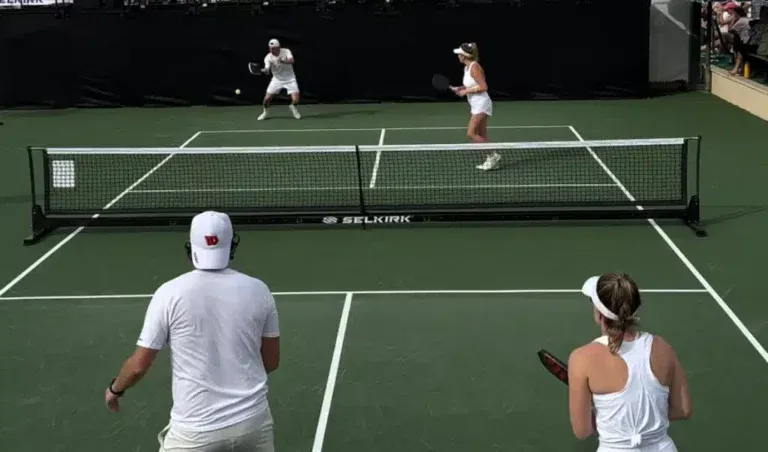
Serving deep: Pushing your opponents back
The significance of a pickleball deep serve lies in its ability to force opponents to the back of the court, making it challenging for them to return effectively. By serving deep toward their backhand, you'll often receive weak returns, granting you opportunities for an aggressive follow-up shot.
- Targeting depth: Aim for at least the back third of the service box to ensure your serve lands deep.
- Tactical deployment: Use deep serves strategically, mixing them into your regular routine to prevent predictability.
Targeting weaknesses: Exploiting the backhand (and beyond)
Many players have predominant strengths and weaknesses. By focusing on pickleball backhand serves, you can exploit an opponent's vulnerabilities. Deep serves directed towards opponents' backhands create pressure and increase the chance of errors.
- Mapping opponents’ weaknesses: Take note of your opponents’ preferences to target their less favorable shots.
- Change it up: After several serves targeting the backhand, consider transferring to the forehand to disrupt expectations.
The element of surprise: Mixing up your serves
In any sport, predictability is a liability. To keep your opponent on their toes, adopt a variety of serve types. Whether it’s a slice serve that curves unpredictably, a topspin serve that dips from height, or a simple drop serve that surprises your opponent, ensuring diversity in serving will protect you from being read easily.
- Types of serves to master:
- Deep Serves: Push back your opponent.
- Short Serves: Pull them in for a risky return.
- Spinning Serves: Create uncontrolled bounces.
Advanced serve techniques: Adding arsenal to your game
Every player wants that special weapon to turn the tide in their favor, and perfecting advanced serving techniques can provide just that.
The lob serve: Mastering the high ball
The pickleball lob serve can be an effective tool, especially against opponents who may be slightly less mobile or not well-versed in defending against high balls. Often called a "moon ball," this serve arcs high in the air before descending sharply into the opponent's court.
- Timing and height: Focus on height and placement to ensure the ball lands safely in the service box.
- Surprise factor: This serve can catch a player off guard, especially if they're expecting a more traditional, lower serve.
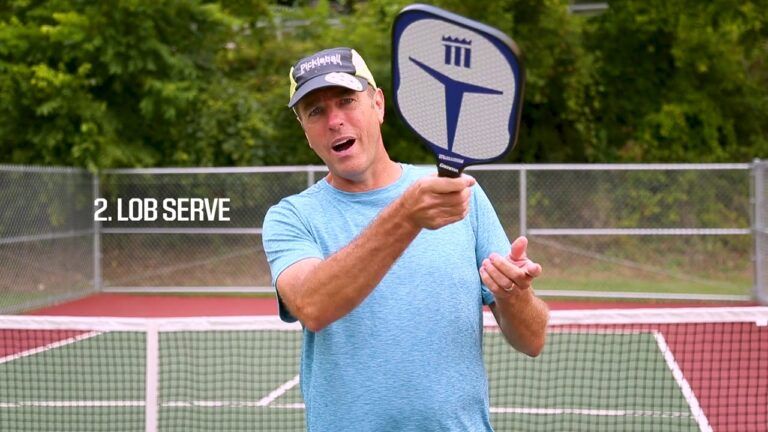
The drop serve: A beginner-friendly weapon
The pickleball drop serve provides a great alternative for players still developing their serve. Unlike traditional methods requiring a strong toss, the ball is merely dropped and struck as it falls. This serves to level the playing field, ensuring even less experienced players can execute a viable serve.
- Low risk, high reward: The drop serve allows you to focus on accuracy over power.
- Ideal practice: Encourage beginners to sharpen their fundamentals without the added pressure of pre-serve tosses.
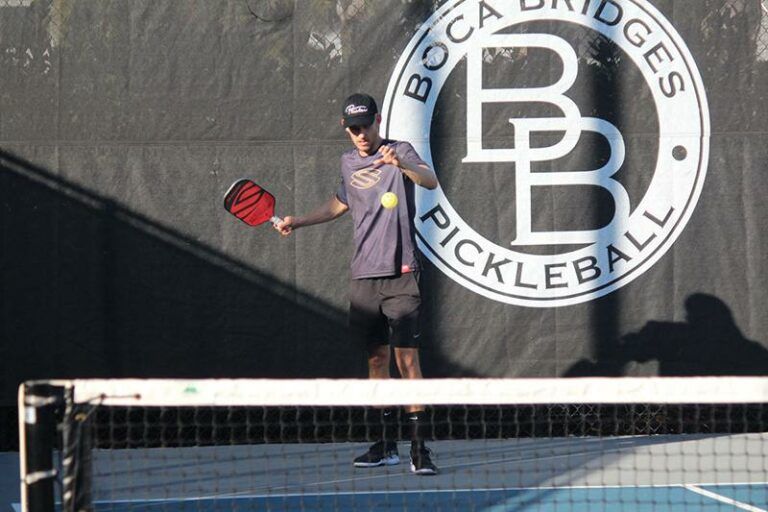
The centerline serve: Catching your opponent off guard
The pickleball centerline serve aims directly down the middle of the service box. This tactic can confuse opponents, as it is not always clear whether to position themselves for a forehand or backhand return.
- Confusion tactics: By serving down the center, you present two potential return paths, causing indecision.
- Variability: Utilize this in conjunction with other serves to maintain unpredictability.
The kitchen corner serve: Precision placement
As an advanced technique, the pickleball kitchen corner serve requires both accuracy and finesse. Aiming for the corners of the service box pushes players of the opposing team to their limits and forces them into difficult resets.
- Focus on precision: This serve is less about power and more about placing the ball in spots that challenge the recipient.
- Create angles: By angling the serve, you can stretch your opponents and create greater openings for subsequent plays.
The power serve: Delivering the heat
Finally, the pickleball power serve is often a showstopper. It’s characterized by force and speed, aiming to overwhelm opponents right from the outset.
- Drive and rip: Emphasize explosive energy from the legs and core while maintaining paddle control.
- Training and conditioning: Regular practice in power serves can improve your overall serve velocity, keeping opponents on alert.
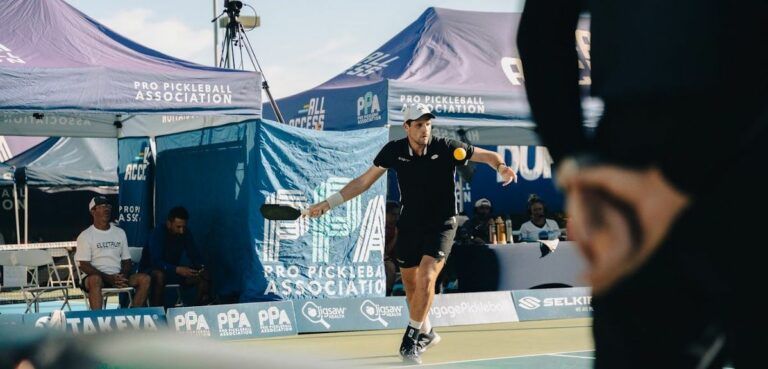
Serving in doubles: Strategies for teamwork
When playing doubles, serving becomes a collaborative effort that can set the tone for each point. Understanding how to leverage both your skills and those of your partner is crucial.
Communication is key: Coordinating with your partner
Team dynamics in the doubles format elevate the level of play. Establishing a communication routine can provide both partners with insights into where the serve will go and how to position themselves afterward.
- Vocal cues: Use agreed-upon terms or signals to ensure both partners are synchronized.
- Plan ahead: Discuss serve strategies during breaks or before matches to align your approaches.
Court positioning: Maximizing your advantage
In doubles play, ensuring that court positions are optimized can provide a distinct edge. The serving partner should control the service area while the receiving partner readies for a return.
- Formations: Engage in various formations to create challenges for your opponents while covering vulnerabilities.
- Dynamic mobility: Those serving should maintain flexibility in positioning, allowing them to adjust if needed.
Specialty serves for doubles: Creating disruption
Utilizing specialty serves in doubles can disrupt opponents and build confusion.
- Tandem serving: Work together to initiate serves that will stretch your opponents out and variance in angles amidst returns.
- Strategic attacks: Focus on their weaknesses collectively, making it difficult for them to anticipate responses.
The mental game: Serving under pressure
Serving effectively under pressure is as much about mental fortitude as it is about physical ability. Players who can master their mind will find themselves excelling when it counts.
Developing a pre-serve routine
Establishing a thoughtful pickleball pre-serve routine serves as a mental anchor that facilitates focus. It may involve several small actions, such as deep breathing, visualizing the serve, or consistent ball bounces.
- Ritual: Develop a simple but effective method to reharness concentration during high-pressure moments.
- Visualization: Serve well in your mind before you even step onto the court.
Staying calm and focused: Handling nerves
The emotional aspect of serving can be daunting. Practicing techniques to stay composed, such as breathing exercises or mindfulness, can prevent anxiety from interfering with your serve.
- Acknowledge tension: Recognize the presence of nerves without allowing them to derail your performance.
- Develop a mantra: Establish a personal motivational phrase that you can repeat to bolster confidence.
Visualization: Seeing the serve before you hit it
Visualizing your ideal serve can precondition your body for success. Imagine the ball trajectory, contact, and your follow-through with clarity.
- Success imagery: By envisioning successful serves, you prepare yourself mentally for execution.
- Routine reintegration: Pair visualization with physical practice to cultivate deeper confidence.
Serving drills: Practice for precision and power
Regular practice is paramount to refining your serving skills. Engage in drills that focus on both accuracy and power while targeting different areas of the service box.
Target practice: Drills for accuracy and depth
Implementing pickleball serve drills can markedly improve your precision. Set up cones or targets in various sections of the service box that need focus.
- Cone challenges: Aim for designated targets with new serves to promote variability.
- Depth drills: Alternate between deep and shallow serves to diversify skillsets.
Advanced drills: Mastering specific serve types
As your skills develop, so should your practice regimen. Include specialized drills focused on advanced serve types like the lob and the backspin.
- Structured focus: Dedicate specific training sessions to individual serve types, seeking feedback from peers or coaches.
- Adaptability in drills: Incorporate shifting conditions, like changing court surfaces or weather types, for real-world applicability.
Game simulation: Partner drills for realistic scenarios
Engaging in pickleball serve game situations with a partner can allow for applied practice. Create scenarios that require specific serves and responses to train in real-life situations rather than mere mechanical practice.
- Competitive atmosphere: Jam various drills into a single session for a more dynamic practice routine.
- Reflective feedback: Post-simulation discussions can yield valuable insights for both players on their performance.
Adapting your serve: Playing on different surfaces
Playing pickleball on various court surfaces presents unique challenges. Understanding the nuances of each environment can unlock strategies for effective serves.
Indoor vs. outdoor: Adjusting for court conditions
The playing conditions in indoor and outdoor environments can drastically alter your serving strategy. Indoor surfaces can be more controlled, while outdoor elements like wind can affect ball trajectory.
- Surface awareness: Learn how different surfaces respond to serve impact.
- Wind shifts: Adaptments in technique may be necessary to accommodate weather conditions when serving outdoors.
Wind and weather: Factoring in external elements
When servicing outdoors, always assess weather conditions. Utilizing analysis and adjustments based on wind direction is crucial to successful serving practices.
- Adjust your angle: Alter the serve's angle to mitigate wind impact, ensuring your shot stays true to its intended path.
Surface types: Grass, concrete, and more
Different court surfaces require distinct adaptations for your serve. A concrete court may benefit from more power, while a grass court demands precision and placement.
- Engage adaptability: Learning the characteristics of various court surfaces empowers you to tackle any environment confidently.
Serving like the pros: Insights and inspiration
Watching and analyzing professional players can inspire you to enhance your own serve, identifying techniques and serve types that could significantly influence your game.
Learning from the best: Analyzing professional serves
Looking at the pro pickleball serves allows you to dissect techniques that lead to successful outcomes. Analyze their body mechanics, grips, and routines to see what could fit your style.
- Video breakdowns: Use footage to identify elements to incorporate into your practice.
- Technique adaptation: Merge professional strategies with your preferred approaches for a more personalized serve.
Case studies: Serve strategies of top players
Consider investigating the serving styles of renowned players such as Ben Johns and Simone Jardim, who have mastered diverse techniques. Delve into how their serving strategies highlighted adaptability, pressure management, and placement.
- Learning formats: Take notes on particular serves they employ and practice them in your routine.
- Inspiration: Allow their success to motivate adjustments and new techniques for your game.
Evolving your serve: Continuously improving your game
Adopting a philosophy of continuous improvement will keep your serves sharp as you advance. Dedicate training sessions to refine specific strengths.
- Set realistic goals: Devise timelines and measurable outcomes to improve reliability and consistency.
- Stay versatile: Engage in varied drills to cover both essential and advanced shots.
Conclusion
Mastering the art of serving in pickleball is a journey filled with discovery, practice, and strategic thinking. Utilizing proper technique, understanding your opponent, and continually adapting will enrich your overall game. Cultivating a mindset that embraces both physical strategy and mental fortitude empowers not just your serve but also your connection to the game itself. With dedication, reflection, and willingness to learn from both successes and failures, you'll transform your serves into powerful weapons that can dictate the pace of play and tilt the match in your favor, making you a formidable presence on the court.










